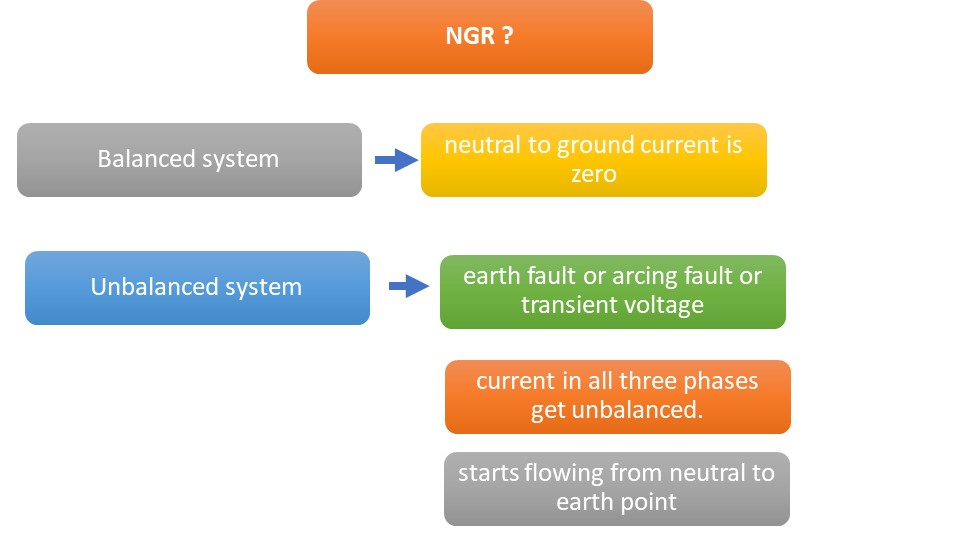Neutral Grounding Reactors For Shunt Compensated EHV Transmission Lines
The application of shunt reactors for controlling the overvoltage in power systems is a well-known practice in EHV systems. A large amount of reactive power generation by EHV transmission lines (400 kV and above) causes power frequency overvoltage during load rejection and line charging.
Thus, line connected shunt reactors are used on long EHV lines for the
purpose of line energization and load rejection. They are typically rated to
compensate 40 to 90 % of the line shunt capacitance.
Use of Neutral Grounding Reactors (NGR), connected at the neutral of these shunt reactors facilitates single-pole reclosure adopted in EHV systems.
Use of Neutral Grounding Reactors (NGR), connected at the neutral of these shunt reactors facilitates single-pole reclosure adopted in EHV systems.
In many of the power systems, tripping and reclosing of all three phases
for a single-line-to-ground fault can cause the system to lose synchronism.
Majority of the power system faults are predominantly single-phase-to-ground
faults and, as such, can be successfully isolated by opening only the faulted phase
(Single Pole Switching – SPS) while the remaining two healthy phases remain in
service. By adopting this, the transmission line is still capable of
transferring two-thirds of the power.
Additionally, SPS applications demand a smaller amount of reactive power
from the system during the single-pole operation period (compared to three poles
opening), thereby improving voltage stability margins.
SPS and Auto reclosing are thus adopted for maintaining power system reliability,
wherein the relays trip the faulted phase breaker pole only and reclosing is
done after a certain dead time. If the fault persists, the relaying scheme
trips all three phases and recloses again or blocks reclosing.
When one phase of the transmission line is opened at both ends to clear the
fault, this faulted phase is coupled capacitively and inductively with the
other two healthy phases of the same circuit (Fig 1) and also with the second the circuit (Fig 2) in case of a double circuit line.
Thereby, the opening of the circuit breakers on the faulted phase at either
end of the line does not necessarily guarantee arc extinction, even if the fault is a temporary arcing fault. This coupling feeds current to the fault arc
before its extinction and thus tries to maintain the arc and it also causes a
recovery voltage across the fault path after its extinction.
The arc on the faulted conductor after it has been switched off is called
the secondary arc. It is much smaller than the primary fault current which exists before opening the
circuit breakers. The Recovery voltage is the voltage existent across the fault
path after the extinction of the secondary fault arc and before reclosure of the
circuit breakers.
The dead time adopted for single-pole reclosure should be sufficient enough
to allow the second arc to extinguish. Thus, the magnitude of secondary arc
current and the recovery voltage are the prime factors for the success of single-pole reclosure.
As the primary cause for secondary arc current and the associated recovery
voltage is the capacitive coupling between phases of the same circuit and inter
circuit capacitive coupling in case of double circuit line, neutralizing this
capacitive current by an inductive current will enhance the success of SPS,
especially on long EHV lines.
In practice, with 400 Kv lines and above, special compensation schemes are
adopted to limit the secondary arc current and recovery voltage to ensure successfully
high-speed single-phase reclosing.
Various compensation schemes based on the use of additional reactors called
as Neutral Grounding Reactors (NGR), connected between line reactor neutrals
and ground, are being in use.
SINGLE POLE RECLOSURE:
Some of the approaches used by utilities for successful single pole
reclosure is, use of
(a) Neutral Grounding Reactor
(b) High-speed Grounding Switches or
(c) Increase in dead time.
Neutral Grounding Reactor
One of the methods adopted for secondary arc extinction is to use a
single-phase reactor in the neutral of the shunt reactors when the transmission line is compensated with shunt reactors.
High-Speed Grounding
Switches
When shunt reactors are not provided on transmission lines, the use of high
speed grounding switches are an effective method for the extinction of the secondary arc
current associated with single-pole switching.
Increase in Dead Time
The method of increasing the dead time for facilitating single pole
reclosure can be adopted for short line lengths (less capacitive coupling) and
when stability is not a major concern.


















Comments
Post a Comment